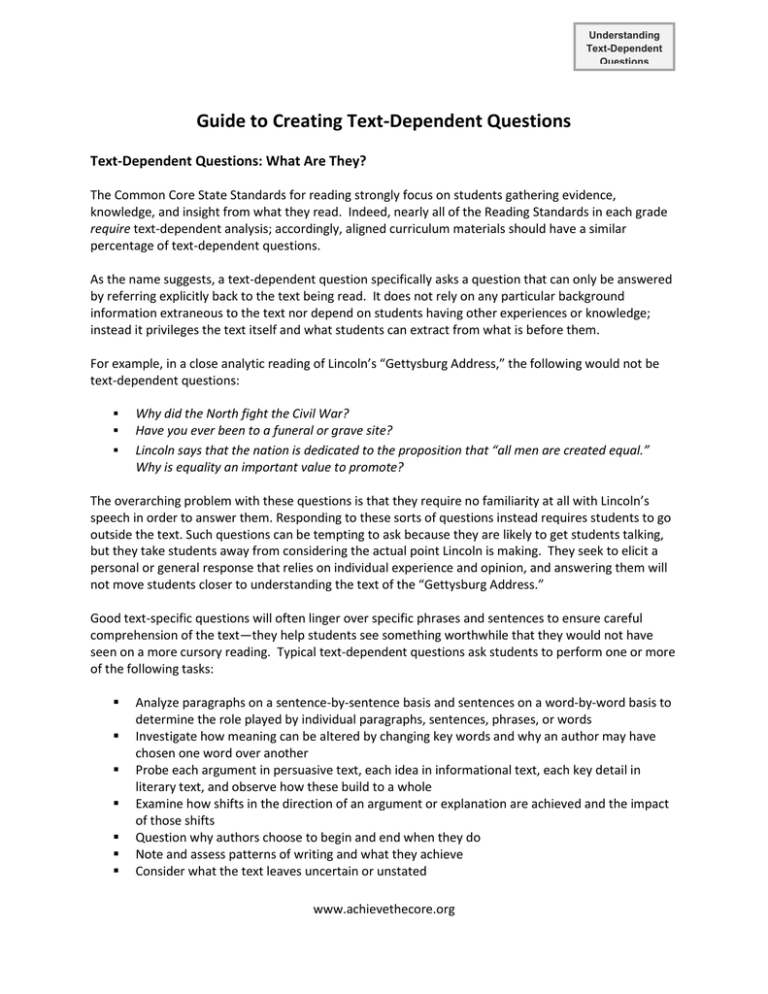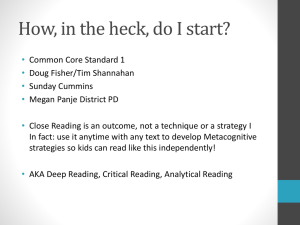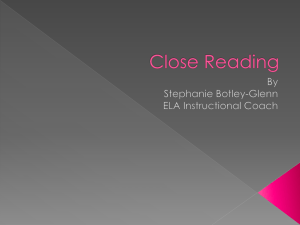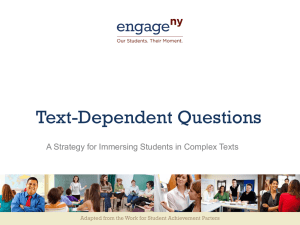Guide to Creating Text Dependent Questions
advertisement

Understanding Text-Dependent Questions Guide to Creating Text-Dependent Questions Text-Dependent Questions: What Are They? The Common Core State Standards for reading strongly focus on students gathering evidence, knowledge, and insight from what they read. Indeed, nearly all of the Reading Standards in each grade require text-dependent analysis; accordingly, aligned curriculum materials should have a similar percentage of text-dependent questions. As the name suggests, a text-dependent question specifically asks a question that can only be answered by referring explicitly back to the text being read. It does not rely on any particular background information extraneous to the text nor depend on students having other experiences or knowledge; instead it privileges the text itself and what students can extract from what is before them. For example, in a close analytic reading of Lincoln’s “Gettysburg Address,” the following would not be text-dependent questions: Why did the North fight the Civil War? Have you ever been to a funeral or grave site? Lincoln says that the nation is dedicated to the proposition that “all men are created equal.” Why is equality an important value to promote? The overarching problem with these questions is that they require no familiarity at all with Lincoln’s speech in order to answer them. Responding to these sorts of questions instead requires students to go outside the text. Such questions can be tempting to ask because they are likely to get students talking, but they take students away from considering the actual point Lincoln is making. They seek to elicit a personal or general response that relies on individual experience and opinion, and answering them will not move students closer to understanding the text of the “Gettysburg Address.” Good text-specific questions will often linger over specific phrases and sentences to ensure careful comprehension of the text—they help students see something worthwhile that they would not have seen on a more cursory reading. Typical text-dependent questions ask students to perform one or more of the following tasks: Analyze paragraphs on a sentence-by-sentence basis and sentences on a word-by-word basis to determine the role played by individual paragraphs, sentences, phrases, or words Investigate how meaning can be altered by changing key words and why an author may have chosen one word over another Probe each argument in persuasive text, each idea in informational text, each key detail in literary text, and observe how these build to a whole Examine how shifts in the direction of an argument or explanation are achieved and the impact of those shifts Question why authors choose to begin and end when they do Note and assess patterns of writing and what they achieve Consider what the text leaves uncertain or unstated www.achievethecore.org Understanding Text-Dependent Questions Creating Text-Dependent Questions for Close Analytic Reading of Texts An effective set of text-dependent questions delves systematically into a text to guide students toward extracting the key meanings or ideas found there. Text-dependent questions typically begin by exploring specific words, details, and arguments, and then move on to examine the impact of those specifics on the text as a whole. Along the way, they target academic vocabulary and specific sentence structures as critical focus points for gaining comprehension. While there is no set process for generating a complete and coherent body of text-dependent questions for a text, the following process is a good guide that can serve to generate a core series of questions for close reading of any given text. Step One: Identify the Core Understandings and Key Ideas of the Text As in any good reverse engineering or “backwards design” process, teachers should start by reading and annotating the text, identifying the key insights they want students to understand from the text. Keeping one eye on the major points being made is crucial for fashioning an overarching set of successful questions and critical for creating an appropriate culminating assignment. Step Two: Start Small to Build Confidence The opening questions should be ones that help orient students to the text. They should also be specific enough so that students gain confidence to tackle more difficult questions later on. Step Three: Target Vocabulary and Text Structure Locate key text structures and the most powerful words in the text that are connected to the key ideas and understandings, and craft questions that draw students’ attention to these specifics so they can become aware of these connections. Vocabulary selected for focus should be academic words (“Tier Two”) that are abstract and likely to be encountered in future reading and studies. Step Four: Tackle Tough Sections Head-on Find the sections of the text that will present the greatest difficulty and craft questions that support students in mastering these sections (these could be sections with difficult syntax, particularly dense information, and tricky transitions or places that offer a variety of possible inferences). Step Five: Create Coherent Sequences of Text-dependent Questions Text-dependent questions should follow a coherent sequence to ensure that students stay focused on the text, so that they come to a gradual understanding of its meaning. Step Six: Identify the Standards That Are Being Addressed Take stock of what standards are being addressed in the series of questions and decide if any other standards are suited to being a focus for this text (forming additional questions that exercise those standards). Step Seven: Create the Culminating Assessment www.achievethecore.org Understanding Text-Dependent Questions Develop a culminating activity around the key ideas or understandings identified earlier that (a) reflects mastery of one or more of the standards (b) involves writing, and (c) is structured to be completed by students independently. www.achievethecore.org





